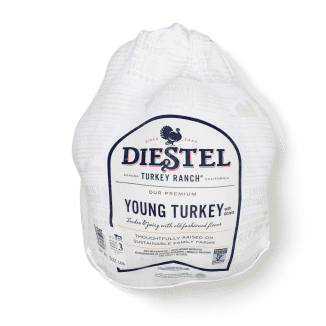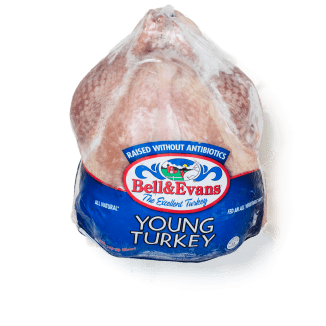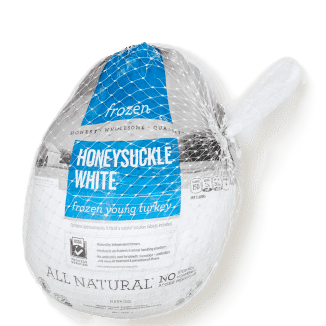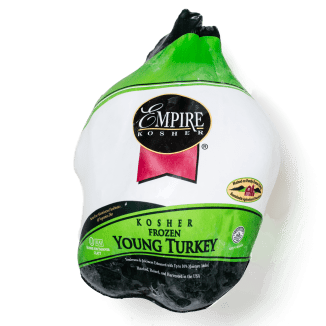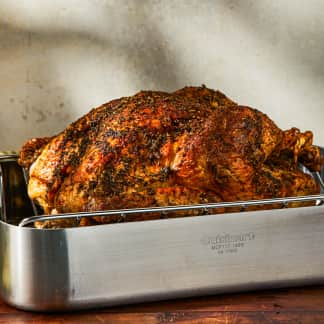Is there any holiday food more fraught than the turkey? First it hogs the refrigerator, and then it hogs the oven. Never mind the logistics of thawing, seasoning, and roasting. After all that, it often turns out dry and bland. A well-tested recipe and the right equipment go a long way toward a better bird, but there’s another variable: The turkey itself matters just as much. To find the best supermarket bird, we purchased eight best-selling turkeys from both national and regional brands. All birds were in the 12- to 14-pound range, which we like for its 10- to 12-serving yield and easy maneuverability. Four were processed without added flavorings or seasonings, and four were treated: one was kosher, which means it was completely covered in salt and rinsed in cold water during processing in accordance with Jewish dietary law, and the other three were injected with salty broths that could also contain other flavorings such as sugar and spices.
We cooked the turkeys according to our recipe for Easier Roast Turkey and Gravy (November/December 2016), which calls for salting the birds for at least 24 hours before roasting. This step seasons the meat and helps it retain moisture while also ensuring crispy skin and good browning. Because the kosher and injected turkeys in our lineup were already treated with salt, we didn’t salt those birds. A panel of 21 tasters evaluated the flavor, texture, and overall appeal of each turkey’s light and dark meat.

Surprisingly, half the turkeys disappointed. Tasters complained that the meat tasted “weak and washed out,” or worse, had musty or funky off-flavors, like “canned tuna” or “dirty water.” Turkey is naturally lean, so we expected some of the meat to be a little dry. We didn’t expect samples to suffer from the opposite problem. Tasters described some of the slices as “wet” or “gummy,” drawing comparisons to a “dampened washcloth” or a “waterlogged sponge.” But there was good news, too. Four turkeys were “amazingly flavorful,” juicy, and tender. What made these good birds good?
Breed, Feed, and Seasoning
First we looked at breed. Seven of the eight producers confirmed that they sell Broad-Breasted White turkeys or other similar breeds that mature quickly and have an abundance of white meat (the eighth, Butterball, declined to comment). Despite the similarities among the breeds, Professor Michael Lilburn of The Ohio State University’s Turkey Center explained that producers work with outside companies to make genetic modifications that fit their specific requirements, so there are bound to be natural differences in flavor, even within the same breed. But other factors were surely also at play.
We found that birds labeled ''vegetarian-fed'' and ''antibiotic-free'' tended to taste better.
We next considered the birds’ diets. Corn and soybean meal make up the bulk of turkeys’ feed, but diets do vary. Michael Hulet, a professor of poultry science at Pennsylvania State University, pointed out that “Commercial diets may [also] contain antibiotics, animal products, and byproducts.” And these components (which are sterilized), he said, “may affect taste.” Intrigued, we examined our lineup and saw that, according to their labels, only the untreated birds were antibiotic-free and were fed vegetarian diets. There’s nothing wrong with an omnivorous bird (wild turkeys eat insects and worms in their natural habitat), but as we learned, bonemeal, feathers, or even blood (such byproducts are sterilized first) can go into the feed of commercially raised turkeys, contributing off-flavors. The producers of the three injected turkeys would not disclose whether their turkeys’ diets contained animal products. Nevertheless, we found that birds labeled “vegetarian-fed” and “antibiotic-free” tended to taste better.

The salt-based solutions injected into the turkeys are meant to enhance flavor and moisture. But in fact, all the treated birds in our tasting were rife with texture issues. The kosher bird had a sometimes-dry, sometimes-spongy texture. And the injected birds were still dry or “borderline gummy” and “mushy,” with an unpleasantly “sticky” quality. Although all the turkeys in our lineup were chilled in water (a routine part of processing that results in added moisture), the treated turkeys had 8 to 10 percent added moisture compared with a high of 6 percent for the untreated turkeys.
Fat played heavily into our rankings, too. The untreated turkeys all had far fattier dark meat, ranging from 2.61 to 4.11 percent fat, than the injected birds, which had between 1.50 and 2.71 percent fat. Analysis of the white meat produced similar results. As for the kosher turkey, its fat levels were similar to those of the untreated turkeys, but it had the most retained moisture (10 percent), resulting in a “strangely wet” texture and bland flavor that counteracted any advantages the fat should have provided.
For a High-Quality Bird, Check the Ingredient List
Many supermarket turkeys are injected with salty flavored liquid that seasons the meat and changes its protein structure so it holds more water. When phosphates are included, they allow the meat to hold even more water. This type of processing may sound promising—after all, we commonly brine turkey and chicken in the test kitchen to improve flavor and moistness. But we’ve found that injected birds (these are often referred to as “self-basting”) can contain funky-tasting spices and seasonings. Furthermore, their retained liquid (up to 9.5 percent) gave them a curiously “gummy” and “mushy” texture. We also had reservations about the Empire Kosher bird processed with salt: It was both wet and dry at the same time. For the best holiday bird, avoid those listing anything other than “turkey” on the ingredient list and follow our recipes’ instructions for brining or salting.
A Better Bird
Any of the untreated, vegetarian-fed turkeys we tasted would be good candidates for your holiday table. All have clean turkey flavor, and we like that you can control the seasoning with these birds. That said, Mary’s Free-Range Non-GMO Verified Turkey jumped to the head of the pack with “rich,” “robust turkey flavor” and “very tender and juicy” meat. For a less expensive option, we recommend our second-place product, the Plainville Farms Young Turkey, which features “concentrated” turkey flavor and “moist,” “buttery” meat. Now that’s something to be thankful for.

- Taste light and dark meat from each turkey. The birds were salted, dried in the refrigerator overnight, and roasted according to our recipe for Easier Roast Turkey and Gravy. (We skipped the salting step for kosher and prebasted turkeys because these methods of factory processing add sodium.)
- Send uncooked turkeys to an independent lab for analysis of fat levels.
- Juicy, moist texture in both white and dark meat
- Rich, flavorful meat that tastes like turkey
- Vegetarian-fed so that the turkey doesn’t pick up off-flavors from the feed
- No salt or injections added during processing, allowing control over the seasoning and preventing any off-flavors and changes to the turkey’s texture




